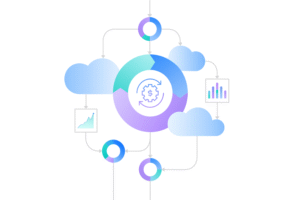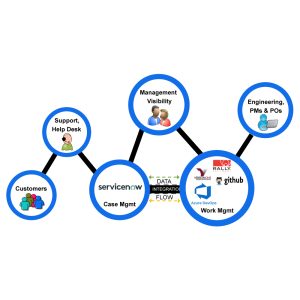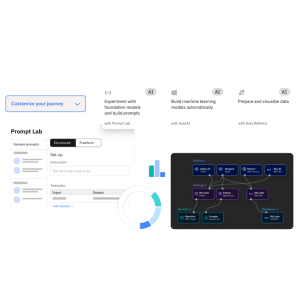Why Enterprise AI Still Fails More Than It Succeeds
Ask any CIO or Head of Data Science, and they’ll admit the same thing: most enterprise AI initiatives stall long before delivering value. Not because organizations lack data, compute power, or business intent — but because AI development is fragmented, slow, poorly governed, and operationally inconsistent.
The common failure points are predictable:
- Data preparation consumes 70% of the project timeline.
- Models created by data scientists rarely move into production.
- Teams work in siloed environments with inconsistent tooling.
- Deployment pipelines are manual, brittle, and non-repeatable.
- Governance frameworks are either nonexistent or superficial.
- Business units expect insights; engineering teams deliver prototypes.
This gap between proof of concept and production AI is where enterprises lose time, money, and competitive advantage.
IBM Watson Studio directly targets these pain points. As IBM’s unified AI model development environment, Watson Studio gives enterprises a structured, scalable, end-to-end workflow — from data ingestion to deployment — wrapped in strong governance, automation, and collaboration. If you’re serious about operationalizing AI at scale, Watson Studio should already be in your roadmap.
What Is Watson Studio and Why Does It Matter Now?
Watson Studio is IBM’s enterprise-grade AI development platform within the broader IBM AI and Machine Learning ecosystem:
It enables organizations to:
- Prepare, clean, and label data
- Train AI and machine learning models
- Automate model selection and tuning
- Manage the full model lifecycle with MLOps
- Deploy models securely at scale
- Govern data, code, experiments, and pipelines
- Integrate with Watsonx, IBM Cloud Pak, and analytics ecosystems
Unlike generic cloud notebooks or fragmented open-source tools, Watson Studio consolidates everything into a single, governed environment.
Why that matters:
- Less tool switching
- Consistent pipelines
- Faster collaboration between data scientists and engineers
- Lower operational risk
- Clear reproducibility
- Easier scaling across teams and business units
This is what makes Watson Studio a critical component of IBM’s enterprise AI stack, alongside:
- Watsonx.ai – AI foundation models
- Watsonx.data – Lakehouse architecture
- Watsonx.governance – AI trust, risk, and compliance
- Cloud Pak for Data – Unified data and analytics platform
Watson Studio isn’t just a tool — it’s the backbone of a modern enterprise AI workflow.
The Reality of Enterprise AI: Why You Need Structure, Not Just Models
Most AI failures come from poor structure, not poor ideas. Here’s the honest breakdown of where enterprises struggle:
1. Data fragmentation is the silent killer
Datasets live in legacy systems, cloud buckets, spreadsheets, operational DBs, and unstructured repositories. Without unified pipelines, no model survives.
2. Development environments are inconsistent
One team runs Jupyter; another uses VS Code; another uses cloud notebooks. Scripts break. Versions conflict. Results can’t be reproduced.
3. Each model lives in isolation
Models trained by data scientists rarely move to production because infrastructure, security, and deployment processes aren’t aligned.
4. Lack of governance undermines trust
Executives need transparency: which model was trained on what data, when, by whom, and with what risk controls. Most systems do not provide that.
5. MLOps maturity is low across industries
AI is not just model training — it’s lifecycle management:
- Versioning
- Monitoring
- Retraining
- Drift detection
- Validation
- Rollbacks
Watson Studio solves these structural gaps.
Inside Watson Studio — The Features That Actually Matter
Let’s cut the marketing noise and stick to what delivers value.
1. Data Refinery for Data Preparation
Data Refinery lets teams:
- Clean
- Transform
- Normalize
- Join
- Filter
- Profile
- Enrich
Large datasets without writing endless ETL scripts.
This integrates seamlessly with:
- Cloud Pak for Data
- IBM DataStage
- Watsonx.data
Data prep becomes repeatable and automated — eliminating the most painful AI development bottleneck.
2. AutoAI for Automated Model Training
AutoAI automatically:
- Selects algorithms
- Handles feature engineering
- Tunes hyperparameters
- Builds candidate pipelines
- Compares performance metrics
- Exports ready-to-deploy models
This removes guesswork and accelerates experimentation — especially for teams evaluating dozens of models simultaneously.
Enterprise decision-makers love AutoAI because it:
- Standardizes model development
- Reduces dependency on individual talent
- Ensures reproducibility
- Speeds up production timelines
3. Collaborative Workspaces for Teams
Watson Studio supports:
- Data scientists
- Machine learning engineers
- Data engineers
- Business analysts
- Ops teams
All working in the same environment.
Key capabilities:
- Shared notebooks
- Shared data assets
- Shared experiment tracking
- Role-based access
- Integrated version control
- Real-time collaboration
This enables multi-disciplinary teams to work without friction or duplication.
4. Multiple Development Environments
Watson Studio supports:
- Jupyter Notebooks
- Python
- R
- SPSS Modeler
- AutoAI
- Scripts
- Custom environments
Your teams don’t have to abandon their preferred tools — Watson Studio simply unifies everything under governance.
5. Built-in MLOps & Deployment Automation
Watson Studio supports every stage of production deployment:
- Model packaging
- API creation
- CI/CD pipelines
- A/B testing
- Automated retraining
- Monitoring
- Drift detection
- Governance logging
This is AI development done the right way: reproducible, compliant, and scalable.
The Watson Studio Workflow — From Data Prep to Deployment
Here is the complete workflow based on real enterprise implementations.
Step 1: Data Ingestion
Watson Studio pulls data from:
- Databases
- File systems
- Cloud storage
- Object storage
- APIs
- Third-party data sources
- Watsonx.data
- Cloud Pak for Data
This is where integration with IBM Cloud Pak and enterprise data pipelines matters.
Step 2: Data Preparation & Refinement
Using Data Refinery, teams:
- Profile data quality
- Remove outliers
- Correct formatting
- Generate features
- Build reusable pipelines
Prepared data is then versioned and stored securely.
Step 3: Model Development
Teams use:
- Notebooks
- AutoAI
- SPSS Modeler
- Custom scripts
Watson Studio automatically tracks:
- Experiments
- Metrics
- Parameters
- Code versions
- Training data versions
This creates traceability — essential for compliance and audits.
Step 4: Model Evaluation & Comparison
Watson Studio automates evaluation using:
- ROC curves
- Precision-recall
- RMSE / MAE
- Accuracy
- F1 score
- Confusion matrices
- AUC metrics
Executives get a clear report of what works and why.
Step 5: Deployment
Deploy models as:
- REST APIs
- Batch scoring pipelines
- Real-time scoring
- Edge deployments
- Containers
All deployments are fully governed with version control.
Step 6: Monitoring & Lifecycle Management
Watson Studio handles:
- Model drift
- Bias detection
- Performance degradation
- Automated retraining
- Alerting
- Rollback
- Logging for audit compliance
This is where most enterprise AI platforms fail — Watson Studio excels.
Real-World Use Cases — Where Watson Studio Delivers Measurable Value
1. Predictive Maintenance in Manufacturing
Watson Studio processes sensor, telemetry, and machine logs to predict failure patterns. Engineers get early warnings that reduce downtime and protect capital equipment. This shifts maintenance from reactive to fully predictive, increasing operational reliability.
2. Customer Risk Scoring in Financial Services
Models trained in Watson Studio evaluate customer behavior, credit patterns, and anomalies.
Banks gain consistent, audit-ready scoring pipelines aligned with regulatory standards. The result is reduced fraud, faster decisioning, and stronger portfolio risk control.
3. Healthcare Diagnostics & Research
Watson Studio enables reproducible AI pipelines for clinical imaging, patient triage, and disease modeling. Researchers can process massive datasets without compromising governance or compliance. This accelerates diagnostic accuracy and supports evidence-based treatment decisions.
4. Retail Demand Forecasting
AutoAI analyzes sales history, promotions, seasonality, and supply chain constraints.
Retailers use these models to optimize inventory levels and reduce stockouts or overstock. It strengthens merchandising decisions and improves revenue forecasting accuracy.
5. Contact Center Optimization
Watson Studio builds predictive and classification models that power real-time insights. Integrated with Watson Assistant, these models guide routing, responses, and agent decisions.
Customers get faster, more accurate support while centers reduce operational load.
6. Energy & Utilities Optimization
AI models trained in Watson Studio analyze consumption patterns and grid performance.
Utilities use insights to manage loads, detect anomalies, and improve energy distribution.
This elevates infrastructure efficiency while reducing operational risk.
Business Benefits — Why Enterprises Choose Watson Studio
1. Operational Efficiency
Watson Studio automates repetitive data tasks that typically drain analyst time. Teams move faster because workflows, pipelines, and tools are unified in one environment. This creates consistent, predictable operational processes across the AI lifecycle.
2. Faster Model Deployment
Deployment bottlenecks are eliminated through automated packaging, pipelines, and monitoring. Models move from prototype to production without slow handovers between teams. This accelerates AI adoption and drives quicker business impact.
3. Lower Project Costs
Unified tooling reduces infrastructure sprawl and dependency on scattered open-source setups. Teams avoid duplicated effort by sharing assets, code, and pipelines. The organization minimizes long-term AI development and maintenance expenses.
4. Better Model Performance
AutoAI and iterative tracking allow continuous improvement, not one-time experimentation. Models remain accurate because performance drift is detected and corrected early. Enterprises get stable, reliable outcomes that directly support decision-making.
5. Enterprise-Level Governance
Every dataset, experiment, and version is logged for audit readiness and compliance. Executives gain visibility into model lineage, ownership, and risk controls. This fosters trust across regulated industries where transparency is non-negotiable.
6. Seamless Integration With IBM AI Ecosystem
Watson Studio connects natively with Watsonx, Cloud Pak for Data, and IBM integration layers. Data flows, model training, and governance operate as one coordinated system. Organizations gain a scalable AI environment that grows without operational friction.
Building AI That Scales Beyond Experiments
Most enterprises fail at AI not because they lack ambition, but because they lack a structured, governed, end-to-end workflow. Watson Studio closes that gap. It brings order to data chaos, consistency to development, automation to deployment, and transparency to governance.
AI shouldn’t live in notebooks. It should run reliably, ethically, and at scale across your entire organization.
Watson Studio provides the environment, tools, and lifecycle oversight required to make that shift — enabling enterprises to move beyond isolated pilots and build AI models that deliver measurable, repeatable, and sustained business impact.
FAQs
1. What is Watson Studio used for?
Watson Studio is IBM’s unified platform for AI model development, covering data preparation, model training, AutoAI automation, deployment, and lifecycle governance. It enables teams to build production-ready AI workflows inside a secure, scalable environment.
2. How does Watson Studio support MLOps?
Watson Studio includes built-in MLOps features like experiment tracking, model versioning, automated deployment, drift detection, and lifecycle monitoring. This ensures consistent, auditable, and scalable AI operations across teams.
3. Can Watson Studio integrate with Watsonx?
Yes. Watson Studio integrates seamlessly with Watsonx.ai, Watsonx.data, and Watsonx.governance, enabling enterprises to combine AI model development with foundation models and lakehouse-scale data architectures.
4. Does Watson Studio support AutoML and AutoAI?
Yes. AutoAI automates feature engineering, algorithm selection, hyperparameter tuning, and pipeline generation — accelerating model development while preserving accuracy and traceability.
5. Can Watson Studio deploy models in real-time?
Watson Studio enables real-time deployment via REST APIs, as well as batch scoring and edge deployment options. All deployments include full version control and monitoring.
6. How does Watson Studio improve collaboration?
It provides shared workspaces, notebooks, data assets, pipelines, and experiment tracking. Role-based access ensures teams collaborate efficiently while maintaining security.




